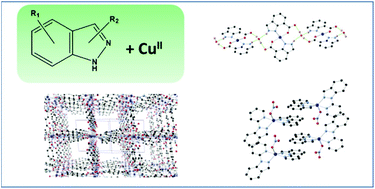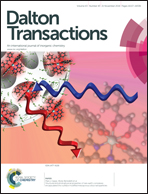Discrete and polymeric Cu(ii) complexes featuring substituted indazole ligands: their synthesis and structural chemistry†
Abstract
Reported here are the syntheses of four indazole-based ligands and the structural characterisation of four Cu(II) complexes derived from them. The ligands 1-(2-pyridyl)-1H-indazole, L1, and 2-(2-pyridyl)-2H-indazole, L2, have been characterised by single crystal X-ray diffraction methods for the first time. The intramolecular structural changes within L1 and L2 that result from the transition from the 1H to the 2H electronic configuration have been delineated. The synthesis of 1H-indazole-6-carboxylic acid, H2L3, and 1H-indazole-7-carboxylic acid, H2L4, is fully described and the structure of H2L4·H2O determined. The structures of two discrete mononuclear complexes {[Cu(L1)2(NO3)]·NO3·1.5H2O}, 1, and {[Cu(L2)2(NO3)]·NO3}, 2, have been determined and their molecular compositions corroborated by solution-based methods. Reaction of Cu(II) with H2L3 generates a 2D coordination polymer, [Cu3(HL3)4(NO3)2(EtOH)2]·3(C6H6)·2(H2O), 3, that features the archetypal [Cu2(OAc)4] paddlewheel motif and 1D channels; whereas reaction with H2L4 gives a discrete complex [Cu(HL4)2]·H2O·MeOH, 4, in which hydrogen bonding interactions link indazole dimers via a water molecule to yield a 1D network.


 Please wait while we load your content...
Please wait while we load your content...